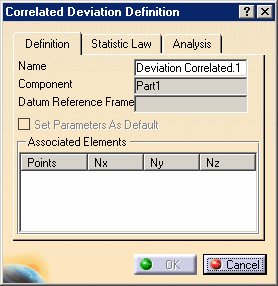- A correlated deviation annotation may be created on an assembly component.
- A correlated deviation annotation represents specified or measured points according to a statistics law.
- The correlated deviation annotation of an assembly component is
contained in its annotation set.
- For a leaf assembly component or a support, correlated deviation annotations represent the input annotations or initial annotations.
- For a parent assembly component, correlated deviation annotations represent the output annotations or annotations to be verified.
- A correlated deviation annotation is already associated with a datum
reference frame.
This datum reference frame must:- Be isostatic at least.
- Be associated with the assembly component where the deviation is created.
-
Select the assembly component.
-
The Correlated Deviation Definition dialog box appears.

- In the Statistic Law tab you can select a measurement file
to define the correlated deviation law.
When no measures file in the Statistics Law field is specified, each point of the correlated deviation is created according to a normal law with a mean of 1mm and a standard deviation of 0.1mm. - In the Analysis tab you can select and define the desired
analysis.
Two analyses are available:- Local, the deviation annotations are take into account where they are defined only.
- Global, the deviation annotations are interpolated on the part or the product.
-
Select the correlated deviation datum reference frame.
-
Click OK to create the correlated deviation annotation.